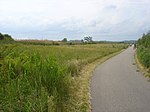Victory Destroyer Plant
1918 establishments in Massachusetts1920 disestablishments in MassachusettsBethlehem shipyardsBuildings and structures in Quincy, MassachusettsDefunct manufacturing companies based in Massachusetts ... and 3 more
Defunct shipbuilding companies of the United StatesFore River ShipyardShipyards of Massachusetts

The Victory Destroyer Plant was a United States Naval Shipbuilding yard operational from 1918 to 1920 in Quincy, Massachusetts. It was then reused as a civil airport, and later Naval Air Station Squantum. It was owned by the Bethlehem Shipbuilding Corporation, and was constructed in order to relieve destroyer construction at the nearby Fore River Shipyard. Still later in the late 1920s it was used to build yachts by the firm Lamb & O'Connell. One of these yachts, the US10 Tipler III, a 30-square-meter racing yacht, participated in the 1929 International Races sponsored by the Corinthian Yacht Club of Marblehead.
Excerpt from the Wikipedia article Victory Destroyer Plant (License: CC BY-SA 3.0, Authors, Images).Victory Destroyer Plant
Harbourside Road, Quincy
Geographical coordinates (GPS) Address Nearby Places Show on map
Geographical coordinates (GPS)
| Latitude | Longitude |
|---|---|
| N 42.299822222222 ° | E -71.02955 ° |
Address
Marina Bay
Harbourside Road
02171 Quincy
Massachusetts, United States
Open on Google Maps









